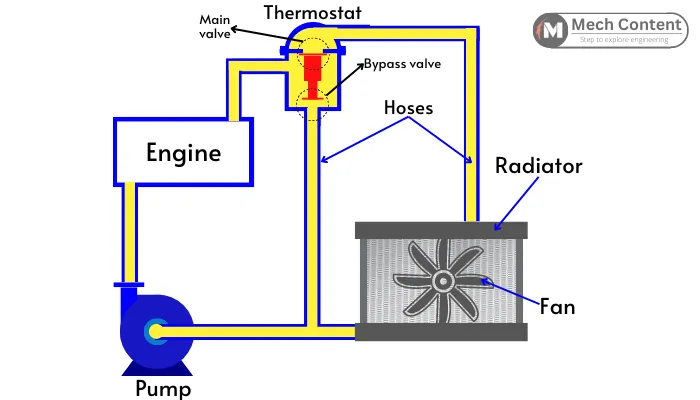
Engines generate a lot of heat inside a combustion chamber. Some of it is used to move the piston, some is vented via the tailpipe, some is used to overcome friction, and some is absorbed by the engine components.
As the engine completes thousands of combustion cycles in a minute, the heat absorbed by the engine components is significantly higher which can harm the engine. The cooling system helps to carry away heat and lowers the temperature of the engine.
Thus, in this article, we will look at the engine cooling system located beneath your car’s hood.
The cooling system in the vehicles is the system that maintains the optimum operating temperature of the engine by extracting extra heat from the engine block and engine head thus avoiding the effects of overheating and ensuring better performance.

As said earlier, the Internal combustion engine produces much heat due to the combustion of the fuel. The excess heat generated during the operation can cause the engine to overheat which can harm the engine components. This can kill the engine in several ways.
Thus, without a cooling system, the engine has to face severe damage, it can even ruin the engine completely.
Other than cooling, the cooling system is needed to maintain the optimum temperature of the engine so that the engine runs cleaner and more efficiently.
The cooling system performs the following important functions:
1] Removes extra heat: It is the main function of the engine cooling system to carry away the excess heat generated by the engine.
2] Helps to attain optimum temperature faster: The optimum temperature means the temperature at which the engine gives better performance. Thus, after starting the engine, it is necessary that the engine should quickly reach its optimum temperature.
3] Regulate engine temperature: The cooling system has a thermostat that controls the flow of coolant passing through the radiator.
If the engine becomes hotter it increases the rate of coolant passing through the radiator and when the engine is cool, cooling is stopped, as the thermostat bypasses the radiator by directly sending the coolant to the coolant pump.
Based on the cooling system used, the engines are mainly classified into the following two types:
The method of air cooling is simpler than liquid cooling. In this method, the heat from the engine surface is carried away by the stream of air flowing over the engine.
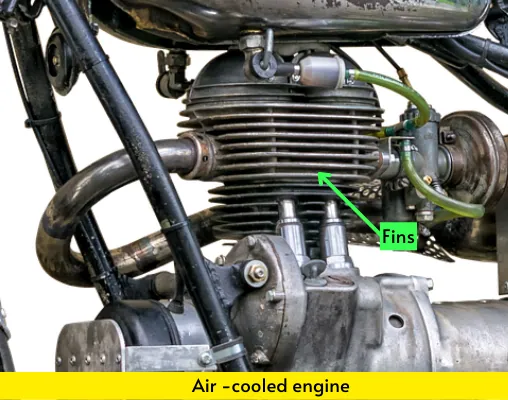
The air-cooled engine has fins over its surface to increase the contact area with the air. The increased contact area increases the rate of heat transfer. Some vehicles use fans to blow air over the fin’s surface.
This method of cooling is suitable for fewer horsepower engines. This method was used in old cars with lower engine capacity. It is still used in two-wheelers to cool the engine.
In a liquid cooling system (Radiator cooling system), liquid coolant is circulated through the coolant passages made in the engine.
This coolant takes heat from the engine parts and reaches the radiator where it emits heat into the atmosphere.
This method is a more efficient way to cool the engines than air cooling, thus it is used in most modern vehicles to regulate the engine temperature.
It is more complex than the air-cooling system and consists of a number of components.
In this article, we are mainly focusing on the liquid cooling system used in most vehicles.
The engine cooling system in a vehicle generally consists of the following vital components:
1] Thermostat:
The end of the piston rod is fixed and the cylinder freely moves.
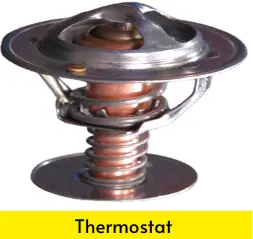
The thermostat acts as a valve to control the flow of coolant to the radiator. The thermostat has a piston rod-cylinder mechanism filled with wax.
The opening of the thermostat depends on the coolant temperature.
As the temperature of the coolant increases, the wax inside the cylinder melts and expands. Thus, it opens the main valve and partially closes the bypass valve.
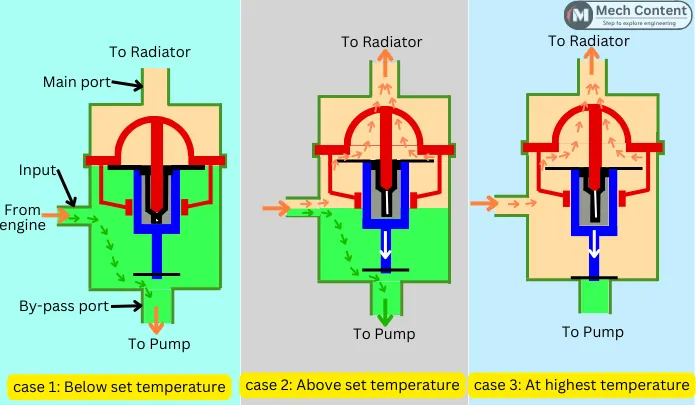
Below the set temperature, the main port is in a closed situation while the bypass port/valve is in a fully opened situation.
As the temperature goes above the set temperature of the thermostat, the main valve starts to open, and simultaneously the bypass valve starts to close.
When the engine is running at a higher temperature, the piston reaches its extreme position to fully open the main valve and to completely close the bypass valve.
2] Radiator:
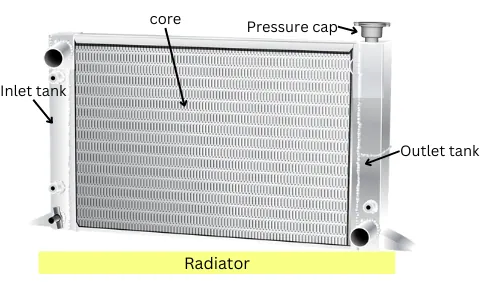
The radiator is the heat exchanger that cools the hot coolant by rejecting the heat to the atmosphere. It consists of a core, inlet tank, outlet tank, pressure cap, etc.
The core consists of a number of thin tubes connected between the inlet and outlet tank. The fins are placed between the tubes to improve the rate of heat transfer. The more contact between the tubes and fins leads to the greater the heat dissipation.
The radiator fan forces the air across these fins to efficiently carry away the heat.
3] Pressure cap and Expansion tank:
The pressure cap (radiator cap) is fitted above the radiator tank, and it is connected to the expansion tank with the help of a hose.
The rating of the pressure cap indicates the maximum pressure at which the pressure cap opens.
The pressure cap maintains the maximum pressure in the cooling system and prevents damage caused due to the higher pressure.
The pressure cap with a higher-pressure rating maintains a high amount of pressure inside the system, which leads to an increased boiling point of the coolant.
Thus, the pressure cap also helps to avoid the boiling of the coolant when the engine works at a higher temperature.
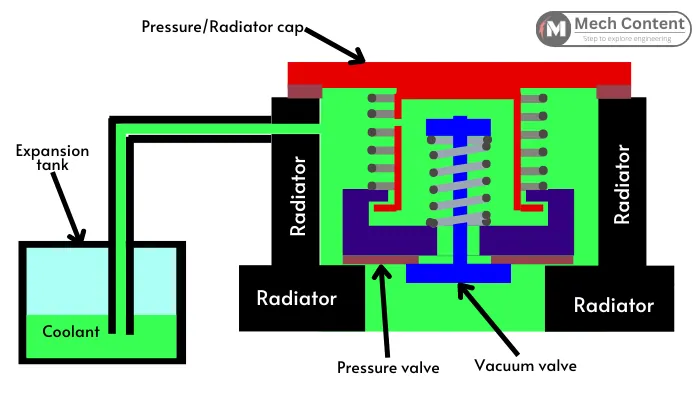
As shown in the above figure, the pressure cap consists of two valves: Pressure relief valve and Vacuum relief valve. The portion of the radiator above the pressure relief valve has a port that is connected to the expansion tank.
At lower pressure, both valves remain in a closed situation.
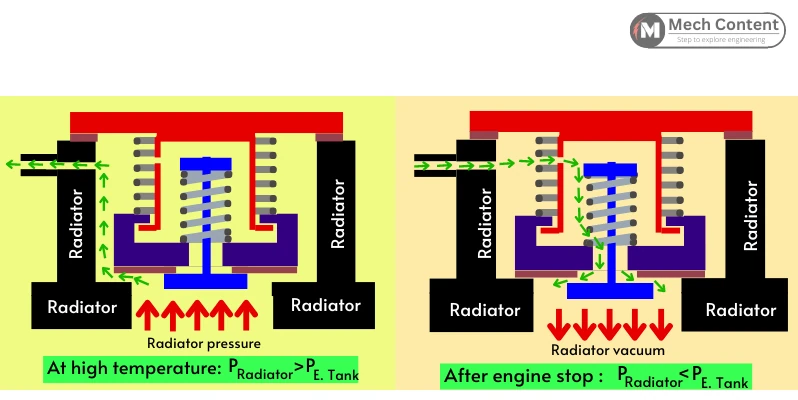
As the temperature increases, the coolant inside the radiator expands, resulting in a rise in pressure.
When the pressure goes above the set pressure, the pressure valve becomes open. Thus, the coolant from the radiator goes into the expansion tank and lowers the pressure inside the radiator.
When the radiator cools down, it lowers the pressure inside the radiator and even creates a vacuum inside the radiator. It causes the vacuum valve to become open so that the coolant from the expansion tank enters the radiator.
4] Coolant:
Engine coolant is the working fluid used in the engine cooling system that helps to carry the heat from the engine to the radiator. It should have a good rate of heat transfer.
The coolant should have a higher boiling point as the coolant with a low boiling point can damage the engine due to overheating.
The coolant should also have a lower freezing point. In case, if the freezing point is higher, then in cold weather, the frozen coolant can burst the coolant system lines.
The coolant should also be less corrosive; thus it will not damage the cooling system components.
5] Pump:
The cooling pump or radiator pump ensures the continuous circulation of the coolant through the system. So, the coolant can carry heat from the engine to the radiator and after cooling the coolant can again circulate through the channels inside the engine.
It is driven by the crankshaft with the help of a belt or chain drive.
6] Fan:
The radiator fan pulls or pushes the air through the gap between the radiator fins. It helps to increase the rate of convective heat transfer.
In some vehicles, the radiator fans are driven with the help of a crankshaft. These fans are controlled with the help of a fan clutch. When the temperature of the coolant goes up, the clutch engages to start the cooling fan, and when the temperature gets lowered the fan clutch disengages to stop the cooling fan.
Some vehicles use electric fans which are controlled with the help of a coolant temperature sensor. When the temperature of the coolant rises above the set temperature, the cooling fan becomes ON and when the temperature of the coolant goes down, the radiator fan stops pulling air through the radiator.
7] Cooling channels:
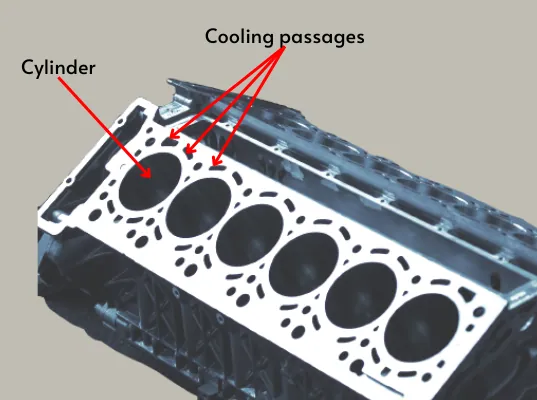
The engine block and head have passages for the circulation of the coolant known as a coolant channel.
The coolant coming from the radiator enters the channels at the bottom of the engine block. Here it gains the excess heat from the engine block and then it is passed to the coolant passages in the engine head. It leaves the engine from the top of the engine head.
8] Hoses:
The coolant hoses are used to connect the various components of the cooling system so that the coolant can flow through all components.
The working of the engine cooling system depends on the temperature of the coolant. Below are the three cases that illustrate the working of the engine cooling system.
After starting the engine, it is necessary that the engine should warm up faster to attain its optimum operating temperature because the engine gives its peak performance (less wear, clean combustion) at the optimum temperature.
Till the engine attains the optimum operating temperature, the coolant is not allowed to circulate through the radiator. This avoids the loss of heat through the radiator and helps engine to get warm faster.
If the coolant is allowed to pass through radiator at lowest temperature, it causes condition of overcooling of engine.
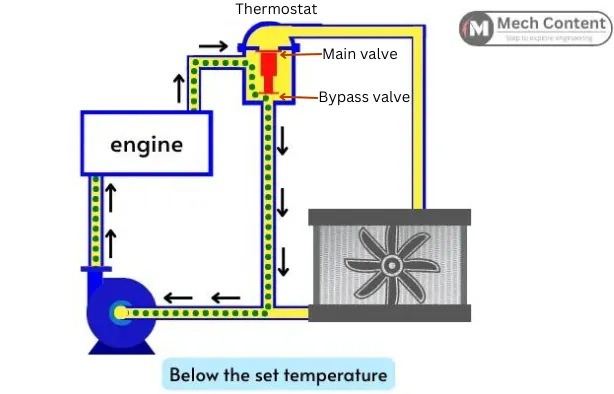
Below the set temperature of the thermostat, the main valve of the thermostat remains closed while the bypass valve is in a fully open situation.
Thus the coolant from the engine enters the thermostat and passes through the bypass port of the thermostat and goes to the coolant pump. As the main valve is in a closed situation, the coolant is not allowed to circulate through the radiator.
As the temperature of the coolant increases above the set temperature, the main valve of the thermostat starts to open while the bypass valve starts to close.
Thus some part of the coolant is allowed to circulate through the radiator and the remaining part of the coolant directly enters the by-pass valve.
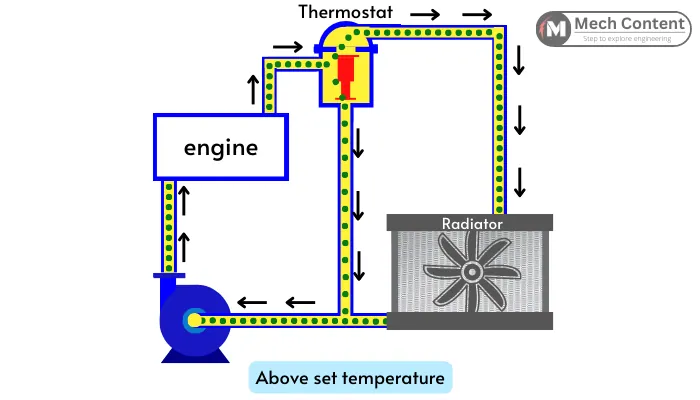
As the coolant temperature goes above the set temperature, the opening of the main valve increases, and the bypass valve opening decreases.
Thus with an increase in coolant temperature, the maximum amount of coolant is allowed to pass through the radiator while the minimum coolant is allowed to pass through the bypass valve.
When the coolant reaches a higher temperature, the main valve becomes fully open and the bypass valve becomes fully closed.
In this case, all the coolant leaving the engine is passed through the radiator and no coolant enters through the bypass valve.
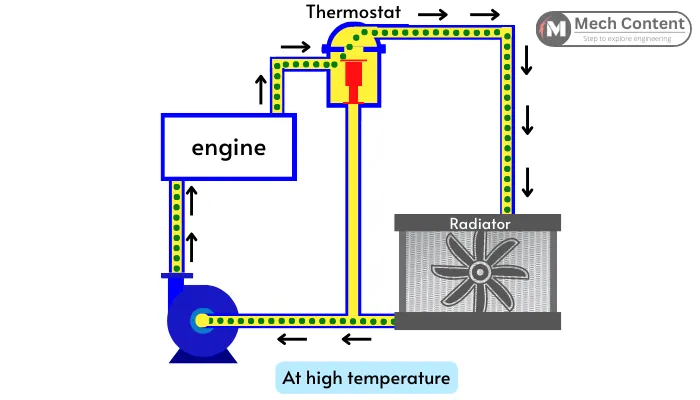
When the load on the engine decreases, the coolant temperature goes down. Thus the thermostat starts to open the bypass valve and starts to slightly close the main valve.
In this way, the cooling system helps to maintain the engine within the optimum temperature range.
What are the different types of engine cooling systems?
The engine cooling system used in vehicles has the following two types: Air cooling and liquid cooling.
What helps to circulate coolant through the radiator and engine?
The coolant pump or radiator pump helps to circulate coolant through the engine.
How does coolant move through an engine?
The engine has coolant passages through which the coolant circulates across the engine.
Categories Internal combustion enginePratik is a Graduated Mechanical engineer. He enjoys sharing the engineering knowledge learned by him with people.